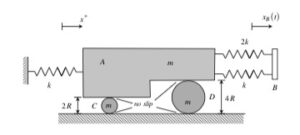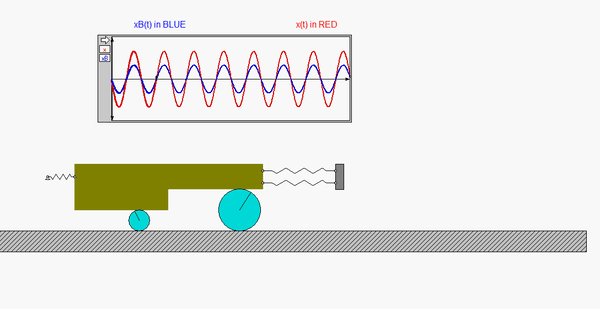| Problem statement Solution video |
DISCUSSION THREAD

Question: Is the excitation frequency ω less than or larger than the natural frequency ωn for the parameters used in the animation below?

Any questions?? Please ask/answer questions regarding this homework problem through the "Leave a Comment" link above.
In order, to solve this problem it would be useful to review base excitation which can be found in the book on page 416. It would also be helpful to look at problem 6.C.8
I agree. Utilizing and analyzing spring by spring was extremely useful for me
The first step to solving this problem is making sure to draw separate FBD's. This allows you to relate the movement of the two disks through their friction forces against the block. Remember to use the no-slip point to set up your equations.
Do the friction forces exerted by each wheel on the block equal each other? If not, is kinematics used to relate each wheel's EOM to each other?
I think the friction forces should be the same as it it's just dependent on the normal force, which would be dependent only on the mass. Since they have the same masses, I imagine they would be equal.
The derivation of the EOM for this problem shares many similarities with the derivation of the EOM for Homework 6.J. Please review that solution video along with the solution video posted here. You will see that all four friction forces for each problem are all different. If you set any of them equal to another, your EOM will be incorrect.
The reason that they are different is that the friction force depends on the dynamics of the motion, and not just on the mass properties.
Each of the circles has friction acting from the ground as well as from the block when looking at the moments around the center points. Additionally, each circle has its inertia acting with the rotation of the system, theta +.
It is helpful when going from the kinematics to the EOM, to find the x-components in terms of theta and convert the derived equation from theta-components to components in order to compute the EOM. This helps with finding the particular solution and its amplitudes and understanding what the phase of the cart is when the base's frequency is excited.
It is very important to make sure, if you choose to use k(x-x_b), to have the spring force pointed to the right. A great way to picture this is to imagine x is larger than x_b which would result in an elongated spring that pulls the block to the right. Another acceptable approach would be to use k(x_b-x) and draw the force to the left.
Start by creating FBD of the two rollers and the cart. Use the FBD of the rollers to relate the frictional forces at their two respective no-slip points to the Newton equation for the Cart. Use this to create an EOM equation to solve for the angular frequency. Also, remember that the cart is out of phase when the Amplitude of response asymptotically approaches zero.
I believe in the scenario you have to pay attention to the instant centers and use the correct radius value for your kinematics. Also remember to account for x(b) and subtract it from x in your spring force equations.
When a problem involves a disk, relating x with theta has always been helpful. Additionally, I found always have x greater than x_b was easier in understanding the direction.
Would you be able to set the instant center of the systems to the contact? Since it's not like we're analyzing an "instant" but instead like the general solution over time, would the instant center therefore be changing or no?
Something that is important in this problem is accounting for the IC's. Also, ensuring that the right radii are used in kinematics.
Make sure to subtract x(b) from x in the spring force equations.
I started working on this problem with the FBD, I found it most useful to use k(x-x_b) along with springs pointing to the right. This way the force provided by the spring is directly related to the relative displacement of b.
When moving from kinematics to the equation of motion, expressing the x-components in terms of theta and converting the equation helps calculate the EOM. This aids in finding the solution, amplitudes, and the cart's phase when the base frequency is excited.
In regards to the kinematics portion I used the contact point as the center in order relate x and theta.
When solving this problem, the EOM is initially in terms of x, theta, and phi which is problematic when solving. The use of kinematics allows us to relate x to theta and phi, which allows the EOM to be expressed in terms of x.
In order to complete the EOM, the sum of forces in the x will have to be added to two sum of moment equations. Each equation will come from a sum of moments of each disk about the bottom point of each disk. Ensure that the FBD is correct in determining the direction of each spring.
For this problem I drew separate FBDs to understand how the forces related to each other. Also keep in mind that the no-slip point makes setting up equations much simpler.
For this problem, taking the moments about the no-slip points of the wheels and ground is important to eliminate friction forces along with the sum of forces in the x direction for the cart.
I agree this makes the problem way easier and you are able to cancel out many of the unknowns and only need to find now less equations
I found it easier to analyze the components separately. For the disk it makes it easier to relate x to theta. Additionally, for the spring x(b) must be accounted for.
Begin by drawing separate FBDs for each components. Then, take the moments of the disks at the nonslip points. Be careful not to equate the friction forces of disks, as they are different. I found it helpful to initially find component values in terms of theta, and then convert them to x-components to find the EOM.